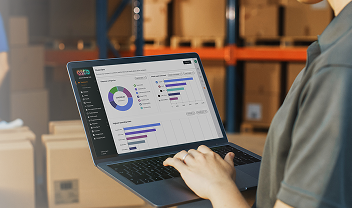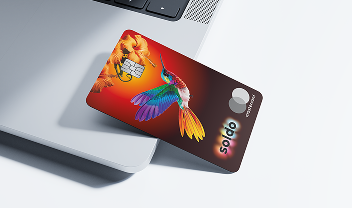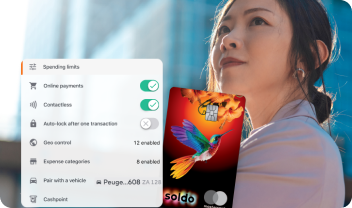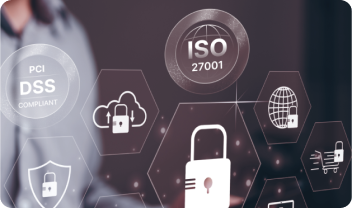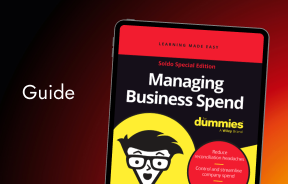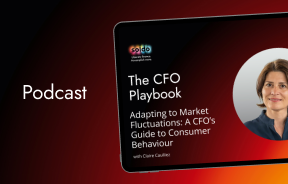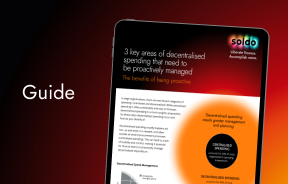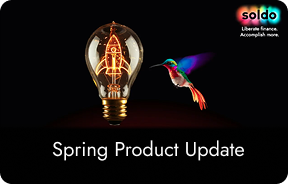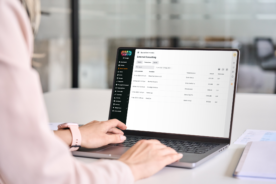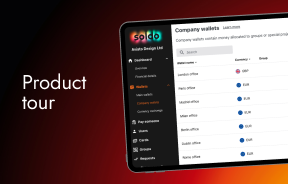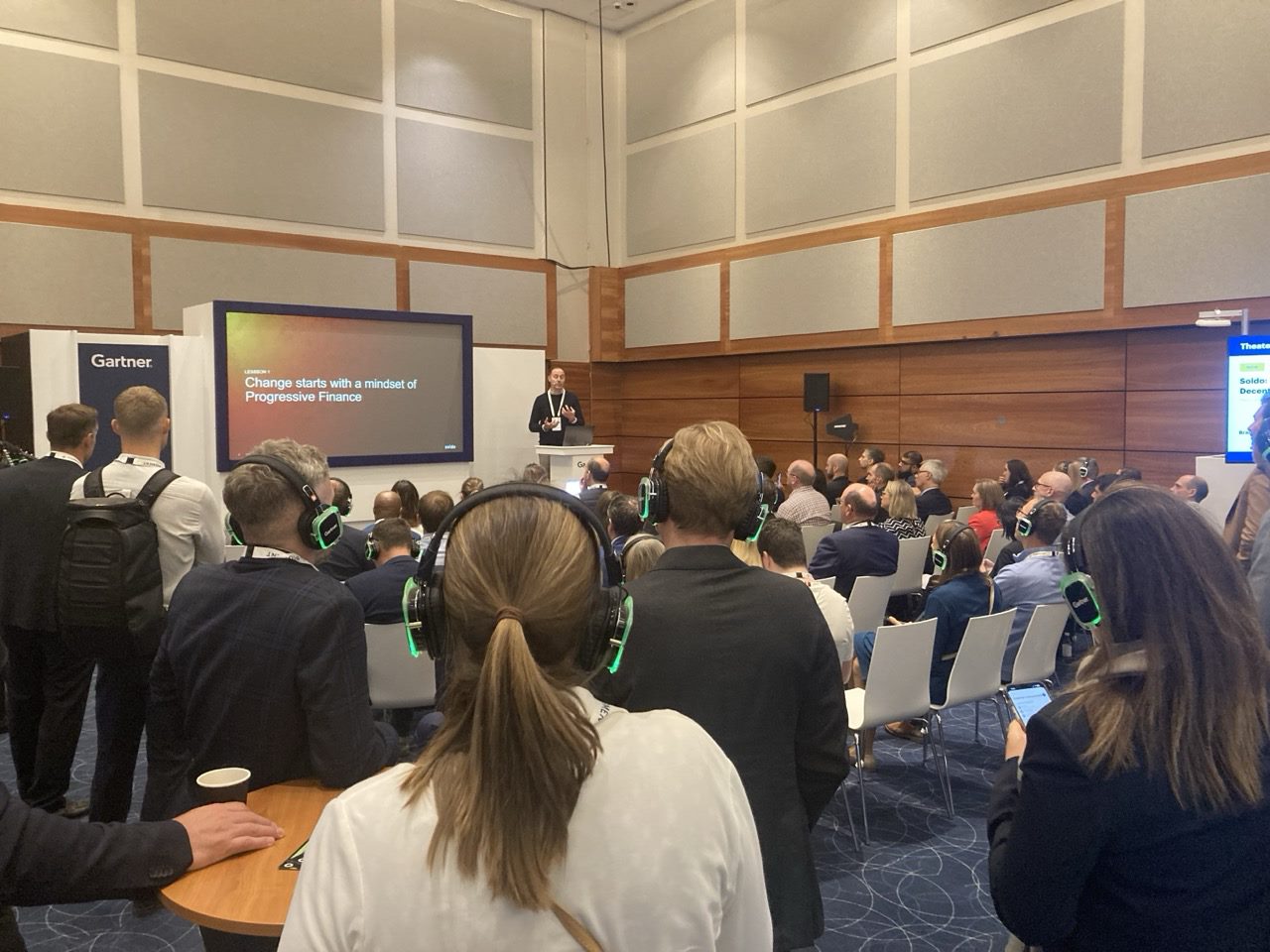If you’re in charge of your company’s “recovery business model”, i.e. cost control, cash management and sustainable business recovery… then this blog post is for you.
In our recent Deep Dive Live session with Daniele Marino, Head of Product Development at Soldo, and Mark Cracknell, Head of Research at Generation CFO, we took a look at some of the best business recovery techniques.
As we’ve all experienced lately, crises tend to rip control out of our hands. But that doesn’t mean that you should surrender to the waves. You need to control what you can and accept what you can’t.
This is the key to the recovery phase.
👀 If you want to read the full show transcript, then just skip to the end, or read on for the summary and key takeaways!
You’ll learn about:
🎛️ A simple but valuable approach to cost control
📑 The top priorities for what to control in your business
💵 The practicalities of cost and cash management during a pandemic📚 Inspiring innovation stories brought about by the pandemic
Today’s experts:
Daniele Marino
Head of Product Development at Soldo. As one of the company’s first employees, he’s driven the platform’s evolution from a fledgling opportunity, to a market-leading solution. He began his career working as a game designer, where he gained knowledge and experience in software development and user experience. Combining that expertise with his background in philosophy, Daniele applies a user-centric approach to product development, understanding the value of different perspectives and subjectivity.
Mark Cracknell
Head of Research at Generation CFO. He liaises daily with a 70,000+ global community of finance professionals to identify the issues they face, as well as understand and work with the technology platforms that are available as enabling solutions. Through webinars, articles, podcasts and discussion Generation CFO aims to help educate the community and understand the ‘art of the possible’ and how this can be successfully delivered.
Christopher Argent
Founder, Generation CFO. Chris splits his time between industry, Digital Finance Function Labs and being editor of GenerationCFO.com. His early career was focused on business partnering, performance and growth strategy, and then finance transformation and technology. Today, he works with finance innovators on digital finance transformation opportunities and behavioural change, so leadership can create effective teams and business solutions.
🔗 Webinar Links
Soldo Care for Governments & Charities
The Controllables and Uncontrollables
Businesses need to be agile enough to adapt to the various conditions that are being thrown at them. But don’t expect to be able to control everything. Some things you can, and others you simply can’t.
So what are your options?
Prioritising Costs
Expenses can be controlled to a certain extent, so you should focus on the areas where you have the highest level of control. Here’s a handy summary table to help you prioritise.
| Cost | Potential Saving | Control? |
| Expenses | Control future spending | High |
| Staff | Furloughing & redundancies | High |
| Overheads | Cut variables, re-negotiate risk | Moderate |
| CAPEX | Cut projects & investments | Moderate |
Income
The same goes for income. You can’t control your customers, especially during the latest crisis, which, in many cases, completely took the customer out of the picture. But you can drive product creation to create new revenue streams.
This takes a great level of flexibility and adaptability, and it completely changes the way businesses spend.
| Income | Potential Increase | Control? |
| Revenue | New/modified products | High |
| Revenue | Customers | Low |
A Shift in Business Spending
So, how are businesses actually spending?
According to our Company Spend Index, there was a 41% drop in business spending from April to March. Despite the seemingly huge impact, a business still has to spend continuously to survive.
What’s really changed?
For one, the nature of the different categories of spending. The most impacted areas of spend have been, unsurprisingly, Travel and Entertainment.
Travel spend decreased by a colossal 92% in April 2020 compared to 2019. Businesses had to concentrate on other areas – such as online software purchases, professional services and subscriptions – which shot up by 81%.
Spending will never disappear for a business. In fact, businesses spend non-stop even when they have to reign expenses in and adapt to a certain situation.
Adaptation
Adapting to a pandemic is certainly no walk in the park, but it’s necessary. To point out the obvious: by tightening expenses, which are your controllables, businesses save money. This may mean changing the employee expense limit and cutting expenses in general.
But it doesn’t stop there.
The next step to take in such a rapidly-changing landscape is to accelerate product delivery. By being agile, you can adjust to the situation and make sure your products fit with the current market.
Issues When Managing Expenses
The vast majority of businesses are running with the usual high street bank account, which means that they can’t check the outcome of their expenditure for quite some time.
But your basic account has no real-time tracking. No way to delegate payment execution. In other words, inefficient and costly processes.
You’re wasting time performing the same paperwork-filled actions at the bank for every employee, then having to wait before seeing the outcomes of what you spend. To add to that, finance teams usually have to check expenses and perform reconciliation manually.
The Simple Way to Control Spending
“Inefficient” and “costly” won’t help a business survive the crisis. In fact, they’ll make survival and growth much more difficult.
Finance teams need a tool that:
📊 Offers excellent data visualisation that can boil down complex data
↔️ Delivers information in real-time
📁 Can do the tedious and manual work that’s usually hurled at finance teams
Soldo is an example of a solution that revolutionises how businesses approach spending.
For instance, it gives the option to set monthly, weekly and daily limits, which can save a significant amount of money. You can also analyse actionable data, which helps resolve common issues, e.g. spending too much or not having enough cash flow.
It even leaves the employee registration to the company itself. No need to chase the CEO for the corporate card anymore!
It’s clear now that there are simpler ways to take back the reins on your business spend.
Webinar Takeaways
Need to know what to take away from the webinar? Here are the best bits…
👉 Prioritise. Handle the controllables.
Mark: “So, during times of crisis, there are so many things that are taken outside of our control. In these situations, all an organisation can really do is control the controllables.” [00:03:18]
👉 If you can’t control, be agile and adapt.
Mark: “Those things you can’t control: be agile and adapt.” [00:45:10]
👉 Diversify your offering and find something that fits with the market.
Daniele: “From our point of view, the way to adapt to the crisis – knowing that a business still needs to spend in order to survive – was to focus on different use-cases, different categories of spending.” [00:07:09]
Full transcript with timestamps
Chris
So good morning, everybody. It’s 11 o’clock UK time and we’re ready to start our Deep Dive Live, this one on controlling the controllables: costs, cash and control. Three hot topics that came up in our research recently and very much the basis of any recovery business model.
So I’m very pleased to be having this in-depth discussion with two great people. Mark from GenCFO advisory, Head of Research. And Daniele Marino, Head of Product Development at Soldo. We’ll be talking a little bit about how his company is changing and how we can use technology to control cash and costs with an eye on this recovery business model.
But first we’re gonna have a quick look at some housekeeping. And we really want to keep this engaged and we always find that Q&A’s from the audience help to bring life to a lot of what’s happening out there and bring some sort of substance to the theory that sometimes we could be talking about, so please use the Q&A functionality. You should see a Q&A box somewhere on your screen. You can also change the screen view and so if you want to see just the slides or if you want to see just the speakers, you can change that. And I’d encourage people to chat amongst themselves in the chat box. But if you want to ask a question, use the Q&A box and I’ll be managing those throughout the session.
This session is being recorded and you will be able to have access to that and the slides. If you know anybody who’s interested in this, then they will be able to sign up to the on-demand recording as well, but it will be a couple of days for that to be live. So I am going to hand over to Mark Cracknell now, our Head of Research and enjoy today’s presentation.
Mark
Right Hi, good morning everyone. And so today I’m joined by Daniele Marino, Head of Product Development at Soldo. So as one of the company’s first employees, he’s driven the blackboard’s evolution from an opportunity to solve a concrete problem, and a market-leading solution. He began his career working as a game designer, where he gained knowledge and experience in software development and user experience. Combining that expertise with his background and philosophy, Daniele applies a user-centric approach throughout development, understanding the value of different perspectives and subjectivity. So good morning to you, Daniele.
Daniele
Good morning, Good morning. Thank you for having me.
Mark
That’s no problem at all. So, let’s set the scene for the discussion today, controlling the controllables. So, during the time of the crisis, there were so many things that were really outside of our control. So in these situations all an organisation can really do is control the controllables. And also then be agile enough to adapt to the conditions that have been thrown at them? So this was definitely the case, and we saw this in our research during this survival phase, where companies were looking to understand and really control their cash position. And a really significant aspect of this is obviously controlling costs of all kinds. If you look at some of the costs that we have as an organisation, we’ve got a number of costs which we can control, things like expenses which are spent, which we can get our arms around and control.
And we have other costs, staff costs etc. Which we’ve got less control over. So it’s really important to concentrate on those cost elements that we can control. If we look at the revenue side of our business in terms of what we can control, for many organisations, the whole customer thing was taken out of the equation. We couldn’t really control what was happening to the end user in lockdown, we didn’t really have the customers to sell to.
So, there are a number of elements that we can control. We’ve seen a number of organisations move their revenue streams and deliver different products. So Soldo – as a young organisation and rapidly growing fintech company, you’ve got a unique view on this I think. First as a software developer, you’re looking at the agility and adaptability to be able to change revenue streams. And the second is developers of a solution which you can give to the community to help control costs going forward.
And the other great thing about it as well is that you probably get to see what lots of people are spending their money on and how that’s changed over the previous 3 or 4 months. So as head of product development Daniele, no doubt you had a product map as we went into the current crisis. How did we see spending change and how did that change the way that you’re going to develop your solution?
Daniele
Yes Mark, everything has changed quite a bit I would say. The current situation with the pandemic has shocked the market, has shocked the businesses. And it definitely caused a drop in business spending. We observed that 41% of business spending dropped in April compared to March. And that basically affected all the businesses. But we have to also say that despite the huge impact, well, a business has to spend in order to survive. So what we have observed is that definitely the relationship to the different categories of spending has changed.
In fact, the most impacted one has been definitely Travel and Entertainment. With the lockdowns across Europe and then all over the world, the possibility to travel basically went down to zero. And that had a huge impact on how businesses want to run their company and the relationship. So, from our point of view, the way to adapt to the crisis, knowing that a business still needs to spend in order to survive, well, it was to try to focus ourselves on different use cases, on different categories of spending.
So, for example, we always try to diversify our offering and this moment, this transformation has accelerated a lot of what we were trying to do in the past. So, we started looking at other use cases like purchases of software online because now it’s more crucial than ever, even just thinking of how we used to communicate. Nowadays it’s all online. That was also the case before but much, much less. It’s incredible to think that now we can talk from our homes and run business as usual.
Mark
Yes, you’ve heard all those people who have been scrambling to subscribe to Zoom and other tools that allow them to communicate. So that’s one big increase and I know from your research that things like professional services and subscriptions, all of those things obviously tie in with that. That need to very quickly give yourself a solution.
Daniele
Yes, that is something that is… again, something we were focusing on before, but now it’s becoming really crucial. And trying to, exactly as I was saying before, diversify and adapt ourselves to the crisis.
Mark
So you’ve found, as an organisation, being agile and adapting quickly was almost critical to you meeting the market needs and needs of your customers.
Daniele
Yes, that is definitely something that you need to be in order to survive. In order to run your business, you need to adjust to the situation that you’re facing. And especially the recent development in terms of software development and technology has given us the opportunity to learn that, if you’re agile and can basically adjust and adapt your conditions, say, in how you propose the offerings of your product in a faster way in order to fit the market, well, that is another important and key factor to the success of your company. That’s why we try to abide as much as possible to these principles.
Mark
Yes, and I suppose one of the big issues has been that move around cash and chip. It’s a very silly example but every time I went to get shopping for my parents, they were giving me cash. And I’ve now got a wallet full of cash because I can’t get rid of cash – no one wants cash! So you’ve had that change as well from cash to needing to use electronic forms of payment.
Daniele
That was and is a big change, but likely for us it’s a big change in the positive. But again, this is due to digital transformation that has been accelerated a lot by these current conditions of the pandemic. And we try not just to grow our business, but also to do some good.
As part of this transformation, we have seen that a lot of charities and government entities have started requiring more and more solutions that are trying to substitute cash with electronic payments. And, in fact, as soon as the lockdown was put in place, we started offering a different kind of solution specifically for these use cases. The initiative is called Soldo Care and basically we try to give the possibility to charities to keep spending through our Soldo cards. So, in that way, they could completely remove cash from the picture and so give them the opportunity to keep going with their operations.
Mark
And have you seen any difference across the different countries, because obviously Soldo works across multiple countries. Do you see differences between the countries or is it the same across all?
Daniele
Well, pretty much it’s the same across all of Europe. The pandemic, let’s say, is not so different in Italy or in France more than here in the UK. The approaches to try to survive have always been the same. So trying to cut costs and trying to save more in order to survive, but also trying to adapt to the situation.
Mark
Yes. So we’ve now got a poll question that we’re going to ask the audience, because it’s an interesting one.
It’s “Have you tightened employee expense rules or limits since the crisis started?” So, something to go out to the audience there. The research we performed 3 or 4 months ago suggested that this was going to be an initiative that most people would adopt. So it would be interesting to see from the audience to see whether they have tightened employee expense rules or limits since the crisis started.
Simple answer there, yes or no!
[Pause]
Mark
Interesting actually! It’s not far from 50/50 in terms of expense limit changes and tightening expenses. It’s an interesting result. We have seen in other research that that was going to be an initiative that people were going to adopt.
Daniele
Yes, especially because in a way, it gives an idea of the fact that a business, in order to run, must keep spending, and on the other side though, you are worried about everything that you’re about to spend. So you try to limit, but at the same time you need to spend. It must be a balance. So in a way, that balance has been reflected by the poll.
Mark
Yes, indeed. So, probably one of the things that is quite important around the whole expense space of course, is that you need the capabilities, as a finance team, to be able to really monitor expenses. And so, what do you think would help organisations in terms of controlling that spend? Because, speaking as a finance person, it always used to be a reactive process, where you get the expense form through and you’d see what people had spent after six weeks. So how do we really get control of it?
Daniele
Let’s say that the beauty of technology nowadays and what the Fintech motion has set in place is a very different scenario in relationship to this story that you were telling. And actually, now, we try to be proactive instead of reactive. So we try to give all the information in advance, we try to give you the whole picture in order to make the most important decisions for your business.
And, most likely you can boil it down to data visualisation, and also the speed of the information. How fast you can get the information. So, on one side, we are currently working on a way to show the data to make it more actionable. Because most of the time you have data reports and also insights that are just an elaboration of what you have. But it doesn’t give you inputs, most of the time it’s relying on the user’s interpretation to take action.
What we are trying to do is give data, but also give you suggestions about what you should do. If you’re spending too much or if you don’t have enough cash flow, this kind of thing in order to properly give you more control over your business.
Mark
I think, in the finance team, the thing that used to frustrate me was exactly that, because you didn’t have the control and you couldn’t see what was going on until, perhaps, that expense was then delivered 3 or 4 weeks later. But then the other problem that we would have would be that, when you take those expenses and post them into your general ledgers, you tend to do it at a high granularity level so you haven’t really got the ability to be able to do that variance analysis and analyse what’s really gone on, because you’ve lost the granularity.
Daniele
And then at that point you will have everything you need in one place. And, most importantly, you will also have this in real time. So you don’t need to wait until the month or until the end of the quarter in order to start working on your accounting.
But you can do it as you go.
Mark
Yes, so you’ve got that control upfront. I remember having long discussions with sales guys who overspent on entertainment or spent on things they shouldn’t have done. But of course, you can only do that retrospectively, and then of course you’ve lost the ability to control.
Daniele
Exactly. Here, thanks to the rules that you can apply, you can prevent a lot of these things – splurging when it’s not needed or due.
Mark
And I think from the slide you’ve got there as well. This just shows a couple of analytics, but if you’re getting this information in real time then that gives you something to act upon very quickly. You know a breakdown of spend by category etc, you know that gives you a very good idea of what’s happening, and then of course, it’s categorised by merchants as well.
Daniele
Yes, and as I was saying, it gives you the possibility to act immediately. When you talk about subscriptions that you’ve flagged, basically one of your subscriptions is getting out of control, you don’t have to go and look for it specifically, because you have a task assigned. But thanks to technology, we can immediately flag that something is wrong, or an outlier that can be immediately highlighted.
Mark
One of the things that used to drive me insane is the old problem of someone subscribing to a software, for example, and that would be allocated to a credit card or something, and then of course you wouldn’t realise that the direct debit had been set up and then the following year another 400 pounds leaves your account – and you’re no longer using that piece of software or whatever you subscribed to. I used to find that a real pain. So if you can get control of things like that, that’s fantastic!
Daniele
And I imagine the surprise of having billed an enormous amount of money without knowing. Well, in our system, the SaaS product that we’re developing will also offer the opportunity to specifically tie a means of payment to a single subscription so that you can also have that level of control in terms of managing the relationship with the specific vendor. So, in those terms, hopefully the help of the technology can bring a lot to the table nowadays.
Mark
So, if we move on, we’ve just got another poll question… poll question number 2.
“How quickly are you able to get information and visualise the results of employee spend after expenditure?”
So, the question is do you get it immediately, 2-5 days, 5-10 days or longer than 10 days? If you’re getting expenses coming in perhaps weekly or monthly. It would be interesting to hear from the participants how quickly they’re able to get information, visualise the results and see how they perform.
[Pause]
Mark
Ok, interesting. So 9% have said immediately, 9% said two to five days, but we’ve got 82% of finance teams who are waiting longer than five days to be able to see what’s going on in terms of expenditure, which is one of those things that you can’t control, so obviously it’s difficult to control for a lot of organisations now. So, is that the kind of thing that you find normally in the market Daniele?
Daniele
I have to say yes, because, let’s say that the market, despite the fact that we talk about Fintech and the revolution of financial technology. Well, the reality is that the vast majority of businesses are still running with their usual high street bank accounts.
So despite the fact that, again, banks are improving their offerings and solutions, they are not there yet, especially because they suffer a lot from their legacy codes. And this is what gives a practical advantage to Fintechs, to the new startups, to the new challenger banks.
And so this is actually very true, the results of the poll where a lot of companies have this kind of issue. If you think of a bank statement that usually comes only once per month. Well, it’s already an example of it.
Mark
Yes, and from my experience as well, I know a young person who recently started on the accountancy route, working in an organisation, a very large organisation. And she was telling me about how painful it is, the period in which she’s having to chase expenses going forward, because you kind of expect big organisations to have a solution around this. But actually, they don’t. They are actually running Excel-based forms which the employee has to fill in, then send to the head office. And so it’s actually quite an arcane solution. But I do find that there are organisations who are still in that position, your ERP solutions can help solve the problem. So I find this is an area which is actually under-invested in.
Daniele
Yes, totally, and it’s totally true because, again, we… and it’s more about culture more than anything else, because if you tend to do always the same things, you will keep doing the same things until either you have the strength to step back and analyse the overall situation and say, well, there are inefficiencies in this process, or as humans we always try to stick to our routines. So there should be something that disrupts the situation in a way that makes us realise that something can be managed differently. And, as in your example, with the expense reports, it’s exactly the same. If you are used to doing the whole work manually, well, you keep doing that until a new product, a new startup comes to you and says, well, actually, there is a different way to manage your expenses that automates the whole process.
Mark
Yes. Or until you’re forced down the route of finding efficiencies and being more effective. Kind of leads nicely to the issues faced in the expense process. And we’ve got a few issues here which we see, we talked about this one already because the visibility and the ability to real-time track the expenses that are going through the organisation. One of the other issues that we face, of course, is that we have no way to delegate execution payments, but perhaps you could elaborate on that one as to what that means.
Daniele
Yes, well, if you think of when you open a bank account, you usually go to the specific bank on the street. You fill in lots of paperwork or maybe you do it online and then you have to go to the bank just to complete the whole registration process. And then you will have to do that for every other person in your company that needs a card. Well, in this different environment and, as an example, in Soldo, we give the possibility to effectively delegate the payments because instead of going through the painful process of getting everyone on board through the registration process, well, we let the company itself self-serve the registration of every single user. It quickly boosts the process in a way to immediately give a piece of plastic or a means of payment so that they don’t have to chase the only person, usually the CEO, that has the corporate card. But they can go and directly spend for what they need to do and focus on their main tasks instead of being worried about “No, where is the money, what should I do? How can I make this happen?”.
Mark
Inefficiency and the cost of manual processes, and this one is very close to all of our hearts, I think in terms of when we talk about financial transformation, we talk about automating those low-level tasks. Really there are a few angles to this – one is the spender, the person who’s making the spend. And I used to be the worst person in the world at it! I was always the last to do it. It was a task that you used on the weekends or evenings, so it was eating into your own personal time. So, you do it as quickly as you can. Accuracy goes out the window. But also from a finance team, when they receive all those expense forms in, then they’ve got to check them, they’ve got to do some kind of reconciliation potentially against credit card statements. And then you’ve got to post them to the general ledger. So, there’s a huge industry related around this whole process that actually can be very, very costly, to you.
Daniele
Yes, definitely. And as you’re describing this, it could be very clear that there are many, many points that can be automated and improved thanks to the help of technology. And this is exactly what we try to do. And we would like to shift the focus of completing the expense report to only the necessary things that are core to the business. So everything that can be already there, like the financial information, it’s not down to the spender to add them. But they should only add the meaningful context of their expenses. So if you are at dinner with the client, for example, it would be important to name the people that were there with you. So those kinds of things are the parts that could be still important to capture through the spender. But everything else should be definitely automated. And the rest you can say for the finance teams. So instead of relying on the checking line-by-line type of work, we should try to give them the possibility either to do their checks, because it’s always good to have the opportunity to be in control, and to make sure that everything is going smoothly, but at the same time immediately reconcile everything between payment and an expense right away. With all the necessary information, some added by the spender, but the rest by the system.
Mark
Yes, and I think we often talk about finance transformation and people think it’s a very grand piece around, you know, some of the very high-level stuff. But actually, this is a very good first step in the financial transformation process. Because you will improve the efficiency, you’re getting benefit out of control, and you’re potentially getting benefit out of analysing those costs that you’re incurring. So, in terms of transformation it’s a very useful step, although some people look upon it as quite a small one but actually it can give a lot of benefit.
Daniele
Yes, and especially when you look at how integrations can be a big play into that. In transferring information between what you used to spend and what you used to take things in account.
Mark
Yes. And then we’ve kind of talked about lack of control over spending, we can kind of go a bit further here and talk about the kind of control that you can put in. So, as you say, you can delegate that control downwards. So you’ve got those controls by person, by staff as well. So, you’ve got quite a matrix of control that you can take.
Daniele
Yes, we try to give as much as we can in terms of control and retaining the possibility to have something to say about the company policies, so that we can adhere as much as possible to what your business needs and how you want to run your business. So, for this reason, there are a lot of rules that can be applied specifically on the card or even on the wallets that contain your money. And it goes from limiting it on a monthly or weekly or daily basis, or even on a single transaction basis.
And also, there are certain types of automations that you can apply in order to keep your business running smoothly. Like automatic transfers, so that you are always sure that you have enough money on your cards. So that when you need to spend, you can effectively spend.
Mark
Yes. I remember one organisation a few years back where I had to rewrite the expense procedure manual, which was like one hundred and fifty pages of every type of expenditure you could possibly have. But, of course, something like this where you’ve got that control built into the solution. Well, it didn’t take it away completely, but you’re automating within the solution because you’ve got the controls there.
Daniele
Exactly, it gives you a lot of help on what you want to allow or not. And exactly as this slide is showing, having the availability of advanced spending control that moves from the possibility of giving you allowance in cash or giving you the possibility to only spend in certain categories. Well, a finance team will definitely have all the granular possibilities to adjust and steer the direction of their business as they please.
Mark
Yes. And have you found that some of the customers you’ve got have used the solution very heavily over this period to change the way that they’re controlling spend? Any feedback from customers on that kind of usage?
Daniele
Well, definitely, as we were saying at the beginning, the pattern of spending has slightly changed, and this has shifted towards the use of company cards, of cards that are mostly related to petty cash or office supplies and being at home, basically having this shift in culture where everybody’s at home, working from home and adopting smart working effectively. Well, also that type of spending has changed because, if before I needed to buy, I don’t know, something in the office, I could go there immediately and buy it with a company Soldo card. Well, now it’s slightly changed because at home I have different needs and sometimes I need to, especially the beginning – I needed to have a screen or a mouse to set up my desk at home. And so in that case, yes, there was a kind shift towards a different kind of expense pattern. No more travel, no more flights, but it was more Amazon general type of spending.
Mark
Yes, so now we move on to a third poll question, where it’ll be interesting to get feedback from the audience about how they would describe the efficiency of their current expense process.
Would you describe it as very efficient, highly efficient, OK, or very poor?
It’ll be interesting to see what people think. My experience of the people that I’ve worked with over the years is that most of them would probably be less than efficient. Because of the solutions they’re using, all the manual processes, it’ll be interesting to see what the feedback is from the audience.
OK, so 70% are saying it’s OK, 20% highly efficient, very efficient 0% or very poor. Yes. So around the OK category, and it’s difficult to diagnose “OK”, it can be that you think it’s working, but it could be better.
Daniele
Well, as I said before, sometimes it’s just because we are so deep into our business and deep in our processes that it’s just more difficult to realise that there are inefficiencies. In a way, even in the most perfect scenario, you will find inefficiencies. So it could be just that there should be some sort of Deus Ex Machina to make you realise that there’s something, “well actually, yes, we can improve that process as well”.
Mark
Yes, and it’ll be interesting to see how people have coped with what seems like a very small change, which is just the recent change in VAT rate around entertainment and everything else, because people have set up solutions which now have got to be modified. And that whole thing has got to work its way through. I mean, I can imagine that this month’s expense checking is going to be a nightmare because you’ve got 10 days at 15% for some expenses, and from July 12th onwards, it’s now down to 5%. So, the finance team again is having to pick up that slack that’s been caused by change in regulation as we go through the month. So, yes, it’s going to be really interesting to see how finance teams cope with that. I’m presuming inside a solution it’s quite quick for you to change that.
Daniele
Yes, it’s also true that if the type of processes that you have in place in order to keep up with the change of regulations are supported by technology, well, that could be much easier. For example, in our case we have in place automations that can help you deal with changes in the taxation and adjusting the tax rate and applying that tax rate immediately when you start spending from a certain moment. So that could be very helpful, for example, in this situation.
Mark
Yes. So if we bring all of that together and say what does a best practice expenses process look like to enable us to control the controllables? There are a number of steps in here.
So first one we’re going to hear is about control, it’s about managing the budget and authorised spending. So that’s the start of the process.
And then we’ve got the delegation to define and control access to money, which you talked about – being able to delegate that down through the organisation. Delegate execution payments we covered.
Capture the context of the enriched transaction data, and again, we talked about the loss of granularity as we move stuff through to ERP solutions and through accounting systems. So, it’s really capturing that transactional data and the detail that we need to be able to fully analyse the data. Validations and control. And integration, which again gives us that ability to be able to automate and to be as efficient and effective as possible. And obviously then have real analytics. So, yes, some of your thoughts on that, Daniele, about that best practice process and how you see that working in an organisation.
Daniele
Well, this is what we’re trying to push into every company that decides to adopt Soldo, trying to give them what could be our best practices to manage the process.
It must also be said that as a solution, we are very adaptable to every kind of process that is already in place. For example, you can decide to delegate the payments, but then you still want to retain the possibility to manually do the whole process of checking the reports, at that point the process could be as easy as exporting the statement coming out from Soldo and to keep doing it manually. Then, at that point, we strongly advise not to do that because again, you can still automate more and in a way to let the machine work for us and then, at that point, give you the opportunity to focus on more important things.
Mark
So I think that gives a really good idea of what a best practice expense process should look like and how that should come across to an organisation. For me the automation of that process and being more efficient and more effective plays into the whole finance transformation journey that we’re trying to push finance teams along.
So, to summarise what we’ve talked about in the time so far.
The key takeaways for me as we’ve gone through today’s session were really about identifying those things you can control, and unfortunately with the crisis, the number of controllables is reduced significantly. But there are still things that we can control, like expenses, which is a very important one. So control the controllables. Those things you can’t control, as you talked about, in terms of the way you adapted your solution and being agile, when you can’t control it, be agile and adapt.
Adapt very quickly to the situations that are there in the market. And on a more granular level for me, expenses can be better controlled through process approvals and new technology. You know, we’ve got great technology there, such as Soldo, that can help us really control that spend. And the other thing, I think, which we really need to be firm about is – it’s not just a short-term fix. This is perhaps a solution and something you can control quite quickly, so there’s a very fast time-to-value in this. But also it is a step on the transformation journey and this is one of the things that finance teams should be doing to be more efficient and more effective. Are there some closing thoughts from you, Daniele, about control and being agile, and adapt?
Daniele
Well, I can only keep saying the same that agility is definitely not the answer to everything, but combining it with adapting to the context and trying to think about what’s going on… Well, the agility of technology also and having a methodology in software development can really help you a lot.
Mark
Excellent, good, good. Thank you very much. I’m just going to open up the questions, I’m not sure whether we’ve got any questions, have we Chris? From the audience?
Chris
Yes, that was great. Thank you very much. We’ve got two questions coming, and if you want to use the Q&A box, we do have some time, probably 5-10 minutes.
So the first one is quite a punchy one I suppose, it’s: “This product is just for card payments and expenses. What about controlling central procurement? Is that not more important?”
So I suppose it’s the value of doing this, maybe as a starting point, and then how far can you go on this journey towards more central procurement, not just expenses?
Daniele
Well this, as everything, needs to be taken in steps. So, we started from a solution that was trying to offer, as pointed out, a way to pay for flights and hotels, the user expenses, the personal company expenses. But then, already at the time, before everything happened, we were giving a solution that was trying to cover the purchases, let’s say. What you can refer to as IT procurement. And now, we are trying to shift our focus, as we said before, trying to exploit the agility of the methodology to develop different types of solutions that can also be adjusted to the specific procurement use case.
And, on that line, we are trying to give the possibility to build specific workflows in order to request authorisation to spend some money, and then effectively give a means of payment that, as of today, is restricted to the card. But it must not be restricted to the card, because for certain things you don’t pay by card, you might want to send a wire transfer. And, again, the agility of technology also means that you need to address things in a step-by-step approach, giving immediately what could be self-contained and used by the market. Then refining and developing the solution more and more into what is close to perfection.
Mark
I think the other thing that the solution gives, Chris, is that procurement is always after information. Procurement can’t do the procurement job unless they know who they are, and I’ve seen procurement organisations try to find information about who you’re spending money with. So, they’re going across multiple systems, trying to find who we’re spending money with. Well, this would actually give you that information. The spend we’re making and in what areas. So, it gives procurement the perfect tool to be able to do the job that they need to do, which is to identify the areas where they can get a spend discount.
Chris
Yes, absolutely, I can see that. Anyone with lots of Zoom purchases recently might want to look at that. So the message is that it’s definitely for wider procurement and purchasing and it’s not just around T&E.
And we’ve got another one here, more of a technical one. “How does the system deal with personal taxable items and things bought from home? Are there P11D reports available?”
Which sounds like a link in to benefits and payroll. On the face of it, it doesn’t look like it does cover that and I wouldn’t really expect it to, I suppose.
Daniele
No, we don’t cover that aspect. What we do is primarily try to provide a way to pay and spend, then we also try to collect as much information as possible, so when it goes to the taxation of specific items that are pertinent to specific semantics or not – well that thing we still leave it to the user to decide how to properly account for it.
Mark
But again, what it might deliver to you is, potentially, the ability to be able to analyse information. Because, yes, we’ve had this task before where the job of trying to find out this information, Chris, then goes back to the general ledger. So someone has to trawl through transactions in the general ledger. So again, any more information you’ve got will perhaps help that process as well.
Exactly. Definitely what can be added in our platform, and it’s already there, is the possibility to better categorise that specific item, that specific payment and seeing that, well, that should have a different type of taxation related to this amount, because, adding a new label, it’s personal expenses related to the purchase of a screen or a monitor or anything else.
So, in that way, when you report and you extract the report out of it, it will be much easier to immediately find the group of expenses that have a certain label and have to be taken into the accounting system in a different way.
Chris
Great, so it doesn’t do it for us, but it certainly gives you the granularity to do it, which is great.
And the last one I’ve here, I suppose it’s more of a general question, bringing it up a level again. “How does this tie to the recovery business model and what other things do we need to be looking out for?”
And I suppose that’s talking about the shift in priorities and, yes, controlling costs has massively gone up as a priority, but what are the other things, you know, cash, forecasting, even breaking even, as a sort of goal. What would be your opinion on that?
Daniele
Well, as we said before, the data visualisation is something that is very important. And, again, the actionability more than just the plain data visualisation is super important. Because the actionability gives you the proper input when you need it instead of waiting for an alert that will come at a later stage, when it’s too late. Having the possibility to react or proactively do something because you already have all the information that you would need in your hands. That is certainly an advantage that you could leverage in your own business.
And in practical terms, it’s not just that you can see the data, but as you mentioned, also forecast what you could need. The example is, looking at the spend patterns that you had in the previous months, we could be able to say that you need more, less, or exactly the same amount for the next month.
So, based on previous patterns, it could be that your cash flow is in exactly the same position. Taking care of potential outliers that are spiking into your spending patterns. Most of the time it could be very important information to have.
Mark
And I think that the recovery phase as well Chris, is all going to be about efficiency, you know, finance teams are going to be pushed again to be more efficient and more effective. And again, the more stuff we can automate, the more efficient we can be, and the more time we can spend on the high-level analysis and the guiding of the organisation.
Chris
Yes, that sounds good. Certainly valuable. And one of the things that we’ve heard about is a lot of reverting to zero-based budgeting. You have to justify your spend every step of the way and you need this level of granularity, and as a budget-holder you need this granularity to prove that the spend is worthwhile in the first place. So it’s not just for the finance teams, it’s for the business as well, to demonstrate that they’re spending in the right areas, which is necessary in this recovery phase because we need to spend all of our pennies on the right areas, the highest value areas.
Chris
Well look that’s it. Mark, I’ll hand it over to you to close, but thanks very much for Daniele and the questions that have come in.
Mark
Thanks very much everyone for joining us today and thanks Daniele for your valuable input. It was really interesting to see what other organisations are doing and the insight you’ve got about the spend, and also what Soldo as a solution can deliver in terms of controlling the controllables. So thanks very much for your time today and thanks very much for joining us today.
Daniele
And thank you for having me.
Mark
Thanks very much.



